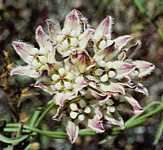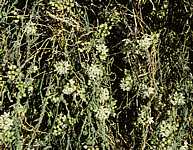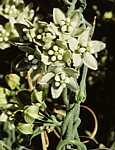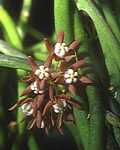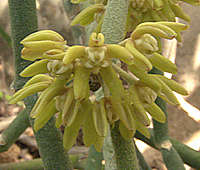|
The genus Cynanchum has contained as many as 400 species but currently includes about 300 species of twining herbs or sub-shrubs that scramble through other vegetation. Most species are non-succulent. Roots are often rhyzomes, leaves are opposite, flowers have the specialist pollination mechanisms of the milkweed family and are followed by pairs of follicles.
Some species of Cynanchum are listed as invasive weeds. The sap of some species is caustic or toxic but a few species have supposed medicinal properties and Cynanchum atratum root features in Chinese traditional medicine 'Bai wei' to treat fever and as a diuretic.
|
|
The genus Sarcostemma is a group of about 40 species of climbing vines and sub-shrubs with leafless or leafy photosynthetic stems. Leaves where present are opposite and heart-shaped to lanceolate. Umbels of small flowers arise from leaf nodes.
The genus Sarcostemma as originally constituted was widely distributed throughout the sub-tropical and tropical Old World in Africa, India and Malaysia. Recently Sarcostemma was reduced to a synonym of Cynachum and many species moved to other genera. Sarcostemma viminale is very common in southern Africa. Similar New World species are regarded as Funastrum in some taxonomic treatments, but may be seen assigned to either genus.
The leafy tropical American genera Philibertia and Vincetoxicum have been included under Sarcostemma, but are currently recognised in their own right.
Several species in this group are listed as invasive weeds and are best cultivated in pots with a climbing frame, where they can be kept under control. The milky sap is toxic and Sarcostemma australe (Caustic Vine) blisters skin on contact. Some species may contain substances of medicinal value. |
|
A group of about 16 species climbing vines with photosynthetic stems, native to the tropical and sub-tropical Americas. Roots are fleshy rhyzomes. The soft opposite leaves and other parts are often slightly hairy.
|

 Families of Succulent Plants
Families of Succulent Plants 



